Layakari in Practice and Performance
About this Section
As we saw in the last section, layakari refers to creating changes of the divisions of the matra (beat). And the most common kind of layakari is the improvised changing of speed in performance.
However, tabla players will change divisions regularly in both practice and performance, often in ways that are much simpler and easier to follow than a master’s improvised performance.
Common division changes include doubling the speed of composition, fixed compositions with division changes, and dedicated layakari exercises. Practicing all of these is essential for developing good lay (steadiness of rhythm).
So in this section we introduce some of the more common division changes in classical tabla, as well as some more advanced examples.
Note that some of examples below are not normally called layakari, such as doubling the speed of a composition, or playing fixed compositions with multiple lays. But I include them here because they do use changes in the division of the matra, and also because they use layakari terminology (dugun, chaugun, aralay, etc.).
Doubling the Speed of a Composition
Doubling the speed of a composition is a common skill that every tabla student will learn early in their training. It is especially common in kayda, and rela practice. And it is one of the first places where students will use layakari terminology.
In kayda practice, students might first play the main bol (theme) in ekgun (1:1), and then play the theme in dugun (2:1).
More advanced students might continue from dugun to chaugun (4:1), or possibly from chaugun to atgun (8:1), depending on the composition, the starting tempo, and the level of the student.
If the kayda is in ara lay (divisions of 3), then students might move from tigun (3:1) to chagun, (6:1), or from chagun to baragun (12:1).
Below is an example of a beginner’s kayda played in ekgun, dugun, and chaugun.
The student first plays the composition in ekgun (1:1):

Then without stopping, he changes to dugun (2:1):
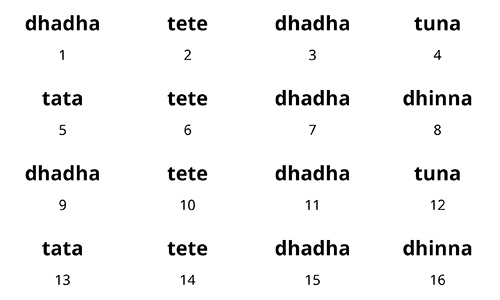
Finally, he changes to chaugun (4:1):
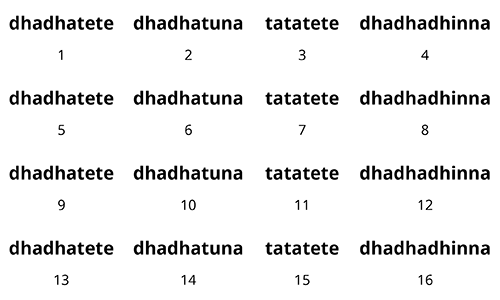
Listen to this kayda played in ekgun, dugun, and chaugun. The theme is played once in ekgun, twice in dugun, and four times in chaugun:
From 2:1 to 3:1 to 4:1 in Kayda Practice
In some traditions, a barabar kayda ("straight kayda" 2:1, 4:1, etc.) may have a variation in ara lay (division of 3). Here students might first play the theme in dugun (2:1), then play the variation in tigun (3:1), and then double the speed of the original theme in chaugun (4:1).
Note that the ara lay variation is not exactly the same as the theme. It must be adapted in order to fit the new division (cutting or adding some phrases).
Below is an example of this based on Dilli Begginer Kayda 1:
Theme in Dugun (2:1):
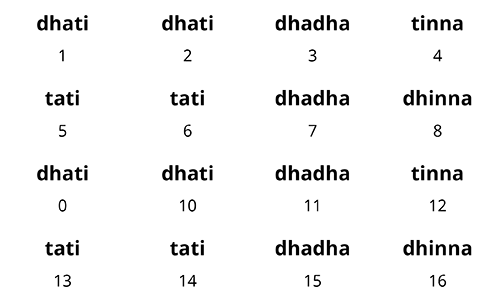
Variation of Theme in Tigun (3:1):
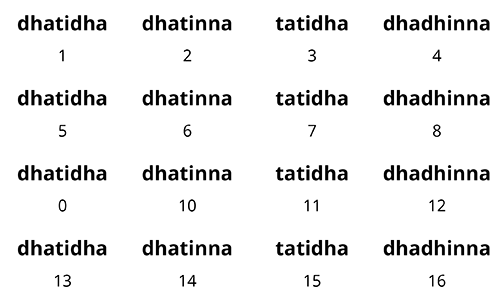
Theme in Chaugun (4:1):
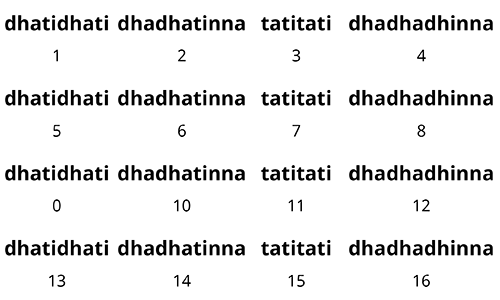
Fixed Compositions with Multiple Lays
Many fixed compositions will have multiple lays (divisions). This is common in forms such as tukra, gat, and uthan.
Below is a Benares Gat which has three different lays: tigun (3:1), chaugun (4:1), and chagun (6:1). Underlined phrases are double-speed:
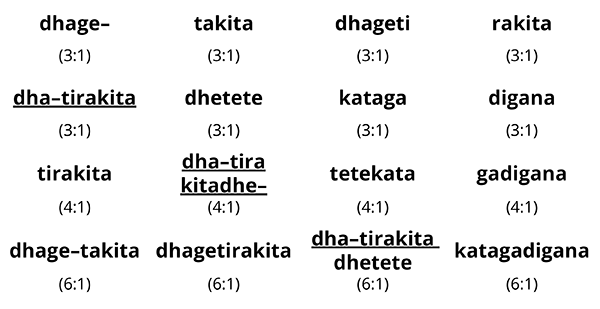
Practicing these kinds of compositions (fixed bols with multiple speed changes) is another excellent way to improve one’s lay, while also learning some of the most beautiful and exciting compositions in the repertoire.
(See also Benares Uthan 3 and Benares Gat 2 for fixed compositions with multiple lays.)
Layakari Exercises
Most students will learn some layakari exercises which are specifically meant to develop their sense of lay (both general rhythm and subdividing skills). In some of the most common exercises, students will play thekas in unusual divisions, or inside of different tals.
Tintal Theka in Multiple Lays
Exercises like the one below appear to be common in all gharanas. Here students play the tintal theka in a number of different lays: ekgun (1:1), dergun (3:2), dugun (2:1), tigun (3:1), and chaugun (4:1), all without changing the tempo. Each cycle of the theka is enclosed in parenthesis.
Tintal Theka in Ekgun (1:1)
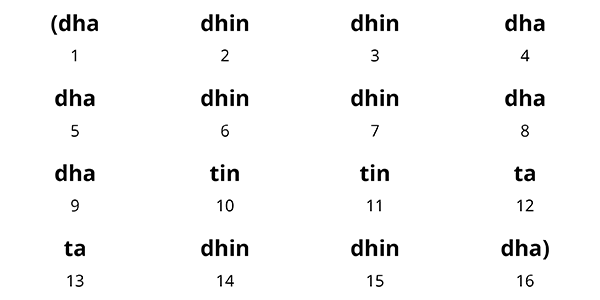
Tintal Theka in Dergun (3:2)
Note: 3:2 means 3 divisions stretched over 2 matras, so each matra includes 1.5 divisions. But to make the written version clear, and to help us when we speak, we divide each division into 2. So the written version below looks like 6:2. Just think of each dash as an extension of each syllable, then it becomes 3:2.
Also, notice that it takes two rounds of tintal for the first dha of the theka to fall again on sam (matra 1) again:

Tintal Theka in Dugun (2:1):

Tintal Theka in Tigun (3:1):

Tintal Theka in Chaugun (4:1):
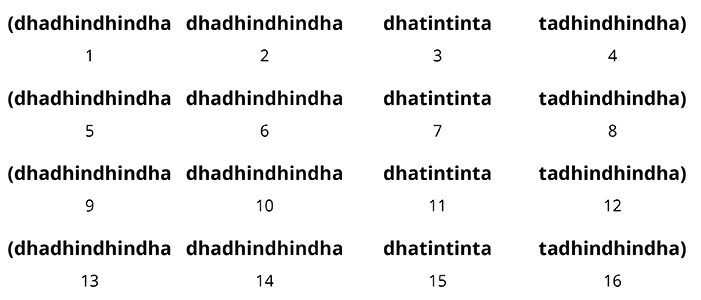
Here is a performance of these 5 different lays above: ekgun (1:1), dergun (3:2), dugun (2:1), tigun (3:1), and chaugun (4:1):
These layakari exercises are excellent pratice for students. They force you to concentrate on multiple things at once: the tempo, the division of the matra, and the sequence of the bols in the composition (theka).
And they can be more difficult to play than you might think. The divisions of dergun (3:2) and tigun (3:1) can be particularly difficult at first, even if you are already comfortable playing compositions of 3:2 or 3:1.
This is because the tintal theka is in groups of four: dhadhindhindha / dhadhindhindha, etc. But the bols are now falling in unusual places. And so the more you practice the tintal theka normally (feeling it in groups of 4), the more difficult it is (at first) to play in divisions of 3.
Tintal Theka inside of Ektal
Another common layakari exercise is to play thekas from one tal inside of another tal.
In the exercise below, the tintal theka (16 bols) is played inside of ektal (12 matras). To do this, each matra is divided into 4 pulses, but each bol is played every 3 pulses. This gives us a repeating 4:3 division (4 bols over 3 matras):
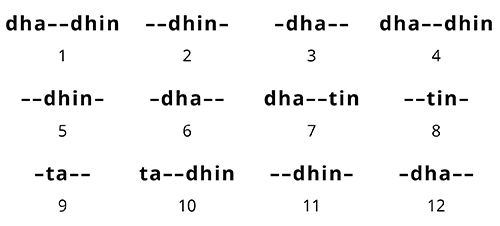
Ektal Theka Inside of Tintal
Slightly more challenging is to play ektal inside of tintal. Here everything is the opposite of the previous: the matra is divided into 3 pulses, but each bol is played every 4 pulses, giving us a 3:4 division:
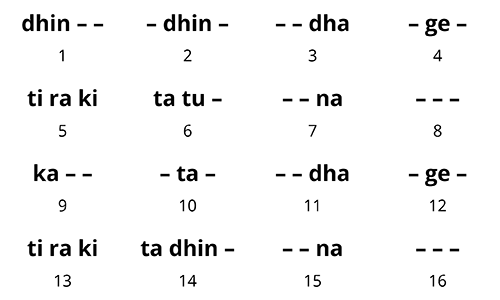
Ektal Theka in Kuaralay (5:1)
Here each matra of ektal is divided into 5 pulses (5:1), but the ektal theka is played in divisions of 4. So the theka must begin from the 3rd division of the 3rd matra of the tal. Very challenging!:
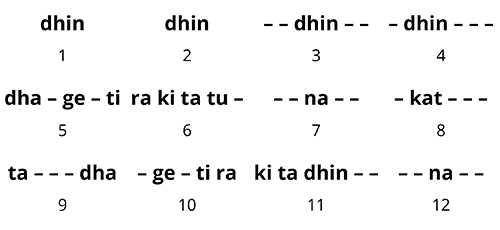
References
Misra, Chhote Lal. Tal Prabandh. New Delhi: Kanishka Publishers, 2006. (Hindi)